Deformed/Curling leaves. Pics. (Unfinished Manure)
archerb
13 years ago
Related Stories

PETSWorld of Design: Pampered Pets and Their 10 One-of-a-Kind Homes
Fall in love with these critters and their clever living spaces, from a cat playground in France to a chicken house in the U.S.
Full Story
KITCHEN DESIGN12 Farmhouse Touches That Bring Homeyness to a Kitchen
Shaker cabinetry, country-store-inspired hardware, barn elements or a key piece of art will add homestead appeal to your kitchen
Full Story
EDIBLE GARDENSSummer Crops: How to Grow Tomatoes
Plant tomato seedlings in spring for one of the best tastes of summer, fresh from your backyard
Full Story
KITCHEN COUNTERTOPSKitchen Countertop Materials: 5 More Great Alternatives to Granite
Get a delightfully different look for your kitchen counters with lesser-known materials for a wide range of budgets
Full Story
KITCHEN COUNTERTOPS10 Countertop Mashups for the Kitchen
Contrast or complement textures, tones and more by using a mix of materials for countertops and island tops
Full Story

The Unofficial Houzz Academy Awards for Movie Homes
Grab a front-row seat as we hand out honors to superb homes featured in 10 flicks. The envelope, please ...
Full Story
LIFEStop the Toy Takeover by Changing the Way You Think
Make over your approach and get gift givers onboard with your decluttering efforts by providing meaningful toy alternatives
Full Story
FEEL-GOOD HOMECarve Out a Neat Little Nook
A well-designed nook can add charm and warmth to a room. Here are ideas for creating one that really works
Full Story
FEEL-GOOD HOMESimple Pleasures: Get Cozy on a Cold Day
Some things are best when the weather is bad. Heat up some cocoa and join the discussion
Full StoryMore Discussions








homegardenpa
digdirt2
Related Professionals
La Marque Landscape Architects & Landscape Designers · Azalea Park Landscape Contractors · Fort Myers Landscape Contractors · Gainesville Landscape Contractors · Kaneohe Landscape Contractors · North Chicago Landscape Contractors · North Haven Landscape Contractors · Pine Hills Landscape Contractors · Pomona Landscape Contractors · Merrifield Landscape Contractors · Peoria General Contractors · Westerly General Contractors · Elkridge Decks, Patios & Outdoor Enclosures · Grandview Decks, Patios & Outdoor Enclosures · Reading Decks, Patios & Outdoor EnclosuresarcherbOriginal Author
soonergrandmom
jean001a
digdirt2
archerbOriginal Author
jean001a
homegardenpa
archerbOriginal Author
garedneck
springlift34
greyghost